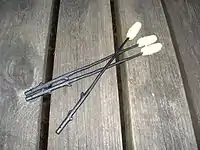Fire eating
Fire eating is the act of putting a flaming object into the mouth and extinguishing it. A fire eater can be an entertainer, a street performer, part of a sideshow or a circus act but has also been part of spiritual tradition in India.



Physics and hazards
Fire eating relies on the quick extinguishing of the fire in the mouth or on the touched surfaces and on the short term cooling effects of water evaporation at the surface on the source of fire (usually with a low percentage of alcohol mixed in the water) or saliva in the mouth. This allows for igniting a damp handkerchief or a bill of money without it burning. Closing the mouth, or covering it with a slap of the hand cuts off the oxygen to the fire. Blowing on it can remove the very thin area of reaction from the source of fuel, and thus extinguish the fire in some cases, where the blown air is faster than the fire front and the flame is small enough to be entirely removed.[1][2]
The flame itself is not a cold flame, and the performers do not use any other material besides the fuel. Certain materials are avoided when doing the trick, such as materials which may easily ignite, melt or store the heat and release it later. These include paraffin candles, plastic, and thick multithreaded rope.[3]
According to Daniel Mannix's 1951 sideshow memoir Step right up!, the real "secret" to fire eating is enduring pain; he mentions that tolerating constant blisters on your tongue, lips and throat is also necessary. Many other fire eaters dismiss this, claiming that skilled fire eaters should not burn themselves. The most common method of safely performing fire eating acts relies on the fact that it takes time to transfer heat, and that heat rises in air. Fire eating and fire breathing (and all variants) is a skill which should be passed on from a skilled master to an appropriate student[3] and almost all teachings include instructions on first aid, fire safety, chemistry and other appropriate skills.[3][4][5] Accidental ingestion of fuel or improper technique can lead to a serious condition known as fire eater's pneumonia.
History
Fire eating was a common part of Hindu, Sadhu, and Fakir performances to show spiritual attainment. It became a part of the standard sideshow acts in the late 1880s and was often seen as one of the entry-level skills for sideshow performers.[6]
Although not the earliest, the first to attract the attention of the upper classes was an Englishman named Richardson, who first performed in France in 1667. Richardson "munched glowing coals, drank flaming liquids, and otherwise appeared to prove that he was unharmed by fire".[7]: 209 His methods were subsequently made public by his servant.[8]
A famous fire eater from the 18th century was Robert Powell who allegedly not only swallowed fire but also red-hot coals, melted sealing wax and even brimstone. He performed, often in front of British and other European royalty and nobility, for nearly sixty years and, in 1751, was awarded a purse of gold and a large silver medal.[9] Other fire eaters include the magicians Ching Ling Foo and Daniel P. Mannix.[7]: 213–214
Guinness World Records
The most torches extinguished in one minute with the mouth (using multiple rods) is 99 and was achieved by Bret Pasek (U.S.) at the Minnesota Renaissance Festival in Shakopee, Minnesota, on 7 September 2014.[10]
In 2018, this record was later beaten by a man named Brant Matthews who extinguished a whopping 101 torches in the same minute time frame.[11]
References
- Why alcohol burns and does not ignite in Classic Chemistry Demonstrations published by the Royal Society of Chemistry. (Google Books)
- Why does a candle blow out when we blow on it? (Answer on Stack Exchange physics questions site)
- Fire eating instructions including instructions repeatedly stressing the importance of an attending experienced skilled master, and giving instructions as to the recommended materials to be used. (juggling.org website)
- Saraf, S (2012). "Fire-breathing burn". Indian Dermatol Online J. 3 (1): 73–4. doi:10.4103/2229-5178.93491. PMC 3481926. PMID 23130274.
- Safety for Fire Eating and Contact Fire (Retrieved from the MIT students portal)
- Blitz' book of magic and fire eating made easy, Library of Congress catalog first published in 1880. (Following a series of books published since 1875)
- Nickell, Joe (2005). Secrets of the sideshows. Lexington, Ky.: University Press of Kentucky. ISBN 0-8131-7179-2. OCLC 65377460.
- "Hot Meals", The Every-day Book and Table Book; or, Everlasting Calendar of Popular Amusements, Sports, Pastimes, Ceremonies, Manners, Customs, and Events, Each of the Three Hundred and Sixty-Five Days, in Past and Present Times; Forming a Complete History of the Year, Months, and Seasons, and a Perpetual Key to the Almanac, Including Accounts of the Weather, Rules for Health and Conduct, Remarkable and Important Anecdotes, Facts, and Notices, in Chronology, Antiquities, Topography, Biography, Natural History, Art, Science, and General Literature; Derived from the Most Authentic Sources, and Valuable Original Communication, with Poetical Elucidations, for Daily Use and Diversion. Vol III., ed. William Hone, (London: 1838) p 314-16. Retrieved on 2008-06-12
- Miracle Mongers and their Methods, Houdini: particularly chapters II, V, VI . Retrieved on 2008-06-12
- "Fire eating – most torches extinguished in one minute". Guinnessworldrecords.com. 2014-09-07. Retrieved 2015-03-03.
- ""Fireguy - Saskatoon Ex". Brant Matthews. 2023-11-08. Retrieved 2023-08-10.
Further reading
- Brushwood, Brian (2002). Professional's Guide to Fire Eating. Bizarre Magic, Inc. p. 170. ISBN 978-0-9713646-0-8. OCLC 224122749.
- Mannix, Daniel P. (1951). Step right up!. New York: Harper. p. 270. OCLC 529468.